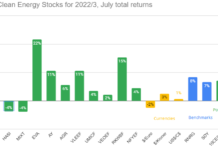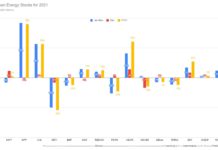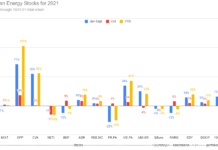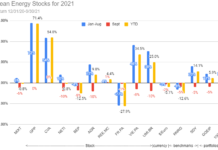Tom Konrad CFA
Every year since 2008, I’ve published a list of ten (or eleven in 2012) clean energy stocks I expect to do well over the coming year. The list is intended as a model portfolio which could be used by a small investor looking to avoid the relatively high costs of clean energy mutual funds, most of which have expense ratios around 2%, in addition to the trading costs they incur with fairly high turnover ratios.
My list also reflects my belief that the best returns and least risk in clean energy stocks are to be found in relatively boring companies involved in using energy and resources more efficiently, rather than from the sexier but less cost effective renewable technologies such as solar manufacturing. Rapid price declines have served to make solar an attractive investment in many places given current subsidies, but the industry remains vulnerable to subsidy cuts.
This belief has served me and readers well. An equally weighted portfolio of my ten stock picks has beaten the clean energy ETF I’ve used as a benchmark for each of the last four years, often by a substantial margin (see chart.) The benchmark has changed from year to year, but, following industry best practice, I’ve chosen the benchmark at the start of the year so readers know I am not retroactively inflating my relative results by choosing a poorly performing benchmark in any given year. In 2013, I will be sticking with the same benchmark I’ve been using for the last three years, the Powershares Wilderhill Clean Energy ETF (PBW), which is the most widely held and liquid clean energy ETF and hence likely to be the best indication of the results of the average clean energy investor. Since I tend to favor small and micro-cap companies, I also use the small cap focused iShares Russell 2000 Index ETF (IWM) to track my portfolio’s performance against the broad market.

The data used to compile this chart can be found in my annual review articles from 2008, 2009, 2010, and 2011. I plan to publish a 2012 year in review article on January 1st or 2nd.
Last year, I said I was finally seeing great values among the available clean energy stocks. Those values translated into a positive return in 2012, despite the significant decline of clean energy stocks in general. While I had been hoping for a repeat of 2009’s stellar performance, I am presented this year with yet another opportunity to pick stocks from an even broader selection of deeply discounted value and dividend paying clean energy stocks.
Without further ado, here is my list of 10 clean energy stocks for 2013, along with their price as of the close on December 28th:
|
Energy Efficiency |
Price |
Last Used |
| Waterfurnace Renewable Energy (TSX: WFI / OTC: WFIFF) | $14.29 | 2012 |
| Lime Energy (NASD:LIME) | $0.56 | 2012 |
|
PFB Corporation (TSX:PFB / OTC:PFBOF) |
$5.53 | n/a |
|
Efficient and Alternative Transportation |
Price |
Last Used |
| Maxwell Technologies (NASD:MXWL) | $8.18 | n/a |
| Accell Group (Amsterdam:ACCEL) | $17.59 | 2012 |
| Zoltek Companies, Inc. (NASD:ZOLT) | $7.52 | n/a |
| Kandi Technologies (NASD:KNDI) | $3.90 | n/a |
|
Renewable Energy Developers |
Price |
Last Used |
| Finavera Wind Energy (TSX-V:FVR, OTC:FNVRF) | $0.225 | 2012 |
| Alterra Power (TSX:AXY / OTC:MGMXF) | $0.396 | 2012 |
| Environmental Services |
Price |
Last Used |
| Waste Management (NYSE:WM) | $33.46 | 2012 |
| Benchmarks | Price |
Last Used |
| Powershares Wilderhill Clean Energy (PBW) | $4.03 | 2012 |
| iShares Russell 2000 Index (IWM) | $82.53 | 2012 |
For those of you wondering why Tesla (NASD:TSLA), Solazyme (NASD:SZYM), Solar City (NASD:SCTY) and other household names are missing from my list, this reflects my belief that the best values are to be found among stocks that few people have ever heard of. These stocks have significant potential to gain as a broader pool of investors become familiar enough with them to invest. With a stock like Tesla, there is a much smaller pool of new investors.
Widely known stocks are also followed by more analysts and professional investors, meaning that it requires much more time and effort to learn something about a stock that other investors are not already familiar with. Given limited time, I choose to focus my research time where it’s liable to be most effective at unearthing the new information that might give me an investing edge.
I chose to focus on the Energy Efficiency and Efficient/Alternative Transportation sectors because these are the most cost-effective alternativ
e energy opportunities, as well as the least reliant on government subsidies. My third sector of focus is renewable energy developers. These stocks are currently deeply out of favor, and have reached such low valuations that mainstream companies and utilities are beginning to see them as very attractive investment opportunities based solely on the reliable cash flows they receive from sales of clean energy. As Finavera Wind Energy’s CEO, Jason Bak recently told me in an interview, small renewable energy developers are so out of favor that he would prefer to take the company private, if funding were available.
Individual Companies
Waterfurnace Renewable Energy (TSX: WFI / OTC: WFIFF)
Waterfurnace has appeared in my annual picks several times over the years because they are a pure-play leader in geothermal heat pumps, which the US EPA calls “the most efficient way to heat and cool a building.” Heat pumps have a high up-front cost, and so they benefit from low interest rates and a high price of heating alternatives, such as natural gas. Recent low natural gas prices have been hurting Waterfurnace’s business, which has recently driven the stock price down and brought the dividend yield up to a very attractive 6.74%.
Lime Energy (NASD:LIME)
Lime Energy’s core business is running energy efficiency programs for small utilities, a business which is expanding rapidly. The stock is currently trading at rock-bottom prices because the company has been conducting an internal review of its past revenue recognition policies since July 2012. The review has recently been expanded to include possible improper revenue recognition all the way back to 2008 and up to and including the first quarter of 2012, and may include up to $15 million in fictitious revenue in the more recent years.
Lime has not published a quarterly financial report since the first quarter, and says all its financial statements as far back as 2008 are not to be relied on, so investors abandoned the company in droves in 2012. While I have my own doubts about how the review has been handled, I think the worst case scenario has more than been priced in. Since Lime expects to report the results of the review in the first quarter of 2013, I estimate that investors who get in today are likely to see price appreciation of 50% or more when that happens.
While Lime has large upside potential at the current price, many investors may feel this stock is inappropriate for their portfolios given the large cloud of uncertainty surrounding the company. For that reason, I will be publishing a follow-up article in the next couple of days discussing six alternative picks which I nearly included in this list from which you can pick alternatives.
UPDATE: That article is now available here.
PFB Corporation (TSX:PFB / OTC:PFBOF)
PFB is a leading North American manufacturer of expanded polystyrene (EPS, aka “Styrofoam”) building products such as insulated concrete forms and structural insulated panels. The stock trades infrequently, and did not trade at all on December 28th, so I will be using the midpoint of the bid and ask for the purpose of measuring its return over the coming year. At $5.53, PFB pays a 5.75% annual yield.
The stock price has fallen significantly after the planned purchase of NOVA Chemicals’ Performance Styrenics business as a move towards vertical integration with the acquisition of the EPS manufacturer. This deal fell though, and many investors sold the stock, driving it down from the mid $7 range to the mid $5 range where it is today. Already a good value, PFB stands to gain from continued recovery in the housing market or any increase in investor recognition. However, since the stock is so illiquid, larger investors will probably want to substitute one of my upcoming alternative picks for PFB, while small investors should limit themselves to good-til-cancelled limit orders to avoid paying over the odds for their shares.
Maxwell Technologies (NASD:MXWL)
Maxwell Technologies is a leading manufacturer of electrodes for ultracapacitors. Ultracapacitors are electricity storage devices which excel in applications requiring high power but low energy and extremely long life. In layman’s terms, they pack a big punch, but have little staying power. They pair well with batteries, which are best in low power, high energy applications.
Ultracapacitors are used in a wide variety of electronics and electricity transmission and distribution applications, as well as in wind turbines and heavy-duty hybrid vehicles, such as buses. They expect to have a large and growing market in “stop-start” hybrid cars. Stop-start technology is one of the most cost effective measures for improving automotive fuel economy, and auto manufacturers are scrambling to meet increasingly stringent fuel economy standards in both the US and Europe.
The main reason for Maxwell’s current low price has been the lack of a design win with a major manufacturer for start-stop technology using Maxwell’s ultracapacitors. Many investors were anticipating such a win in 2012, and the lack of one so far and slower revenue growth overall led to extreme investor disappointment, driving the stock from over $21 at the start of the year to the low $8 range where it has been recently trading. Maxwell insiders, including the CEO, David Schramm, have been demonstrating their faith in the company’s prospects since the stock fell to $10 with large stock purchases. They have acquired 128,400 shares since then.
Accell Group (Amsterdam:ACCEL)
Accell is a leading bicycle manufacturer and a leader in electric bikes based in the Netherlands with worldwide sales mostly in Europe but expanding rapidly in the United States and Asia. The company’s strategy is to leverage its strong distribution network by acquiring strong brands in a highly fragmented industry. In 2012, they acquired Raleigh, which was a slightly larger than usual acquisition. Integrating Raleigh took longer than management expected, and depressed third quarter earnings and the company’s current share price. The company has a variable annual dividend, but based on the last payment of 0.782 euros, it’s currently trading at a 5.9% annual yield. Stock appreciation in 2013 could be driven by the start of synergies from the Raleigh acquisition, increased adoption of electric bikes in the US, or easing of uncertainty in Europe.
Because smaller investors may find Accell difficult to buy through their broker’s foreign trading desk, they may want to substitute one of my upcoming alternative picks.
Zoltek Companies (NASD:ZOLT)
Zoltek is a leading manufacturer of carbon fiber, which are used for a wide variety of applications requiring high strength to weight ratios. Consumers may be familiar with carbon fiber tennis rackets and racing bicycles, but carbon fiber is also used to manufacture wind turbine blades (Zolek’s largest source of revenue) and to replace heavier steel and aluminum in transportation applications such as Boeing’s Dreamliner 787, performance cars and electric vehicles.&
nbsp; I think it’s likely that automakers pursuit of fuel efficiency standards will lead to more carbon fiber being used in more mass market vehicles to reduce weight and lead to improved fuel economy without sacrificing safety.
The company never recovered from its fall in 2008-9, but company insiders, including its CEO have been buying ZOLT shares since it fell to the $10 range last year, and the company’s fundamentals have been improving even as the stock traded basically flat for the last 3 years. Having lost money in 2010 and 2011, Zoltek made a profit of $0.66 per share on record sales in its Fiscal 2012, which ended on September 30th. Analysts expect $0.52 per share earnings in 2013, for a forward P/E of 14. The company has a strong balance sheet with no net debt and several unused lines of credit at favorable interest rates, and the company has several opportunities to achieve high growth as carbon fiber usage expands in its existing markets and breaks into new markets.
One misgiving I’ve long had about Zoltek is the centralization of power in the hands of its Founder, Chairman, President, and CEO Zsolt Rumy. This concern is ameliorated by his recent stock purchases. These, along with the historically low valuation, led me to add Zoltek to my annual clean energy stock list for the first time.
Kandi Technologies (NASD:KNDI)
Kandi is a manufacturer of ATVs which is creating a new class of mini electric vehicles (EV) for congested Chinese cities. Kandi’s mini-EVs are well suited for rental and leasing programs where the ownership of the the batteries is often separate from the vehicles, which are designed for quick battery swapping. One early agreement has Kandi selling its EVs without the batteries to China’s State Grid utility, which owns the batteries and uses them for grid stabilization when they are not in EVs in use by commuters.
As a Chinese stock which achieved a US listing through a reverse merger, Kandi has been the target of a number of short sellers and articles claiming to expose shadowy self-dealing among industry insiders which has kept the stock at its low current valuation. However, unlike many of Kandi’s Chinese peers, its detractors have yet to uncover the sort of shoddy accounting we saw at such disasters as SinoForest, but not for want of trying.
In 2011, Kandi earned $0.30 a share based almost entirely on its legacy off-road vehicle business. The company’s fans have estimated that just Kandi’s existing EV deals could generate $4.42 in annual earnings in their first year of ramp-up, which could be as soon as 2014 or ’15. I’m not comfortable projecting that far into the future, but I think that $0.60 to $1.20 of earnings in 2013 is quite likely, and would leave the current stock price of $3.90 looking quite cheap at only four to six times earnings in a rapidly growing company.
Finavera Wind Energy (TSX-V:FVR, OTC:FNVRF)
Finavera is a hold-over from 2012 which I had until a week ago expected to drop from this year’s list. That’s because the company had put itself up for sale for a lack of another way to refinance a past-due note from General Electric (NYSE:GE). I expected a sale to be completed early in 2013, which would have meant that followers of my portfolio would have to redeploy funds early in the year.
On December 23rd, Finavera announced a deal to obtain financing from and sell its projects for C$40 to Pattern Renewable Energy Holdings. Investor disappointment at it not being a sale caused the stock to plunge in the thinly traded holiday market to what I anticipate will be a very short-lived buying opportunity in the 20-30 cent range. I just posted a valuation of Finavera stock in light of the Pattern deal here.
Alterra Power (TSX:AXY / OTC:MGMXF)
Alterra is another hold-over from 2012, which I also expected to remove from the list until the stock unexpectedly declined over the last few weeks. Alterra owns a portfolio of run-of-river hydroelectric and Wind projects in Western Canada, as well as geothermal projects in the Western US, Iceland, and Chile. With its diverse and growing portfolio of operating renewable energy projects, Alterra is one of the most stable of the small renewable energy developers, but not yet so big that its assets are fully valued.
A recent agreement with Philippine utility EDC could easily lead to significant price appreciation if the companies jointly develop Alterra’s projects in Peru and Chile as envisioned in the agreement.
Waste Management (NYSE:WM)
The only household name in this year’s list, Waste Management is coming back for an encore performance in 2013. WM is the North American leader in recycling and renewable biogas among waste and environmental services companies. The industry has been in a cyclical downturn, and WM’s well-covered 4.2% dividend makes it a solid anchor for this portfolio of small and micro-cap clean energy stocks.
Conclusion
I’m very optimistic about the prospects for these 10 stocks this year. Two of them (Finavera and Lime) are trading at significantly depressed prices by what I expect are temporary situations; I would be surprised if both are not up 50% by the end of the first quarter. The other eight seem to be temporarily out of favor, driven not so much by company specific events but by the general economic weakness leading them to disappoint previously inflated shareholder expectations. Yet the revised outlook for these stocks is more than enough to justify their current prices, and good news or a more realistic appraisal of their prospects could drive significant prices rises as well.
Even if the world economy worsens or these stocks remain out of favor, Waterfurnace, PFB, Accell, and Waste Management all have high yields (averaging 5.65%) which should provide return and protection against large price declines even if the market tanks. All except Lime, Finavera, and Alterra have profitable operations which should protect them even if the world economy worsens.
That said, the goal of this portfolio is to produce a return that is significantly better than my chosen clean energy benchmark, PBW. If clean energy has another horrible year like 2008 or 2011, we’re liable to see a negative return from this portfolio as well. On the other hand, PBW has recently reversed it former trend, and significantly outperformed the broad market in December. Clean energy stock prices are currently so depressed that I would not be surprised if clean energy stocks gain in 2013 even if the broader stock market falls.
See also: Six More Clean Energy Stocks for 2013
DISCLOSURE: Long WFIFF, PFBOF, MXWL, ACCEL, ZOLT, KNDI, FNVRF, MGMXF, LIME, WM.
DISCLAIMER: Past performance is not a guarantee or a reliable indicator of future results. This article contains the current opinions of the author and such opinions are subject to change without notice. This article has been distributed for informational purposes only. Forecasts, estimates, and certain information contained herein should not be considered as investment advice or a recommendation of any particular security, strategy or investment product. Information contained herein has been ob
tained from sources believed to be reliable, but not guaranteed.








Surprisingly many Canadian stocks, are you from the great white north?
No, but I often find that stocks that trade in Toronto are better values than those which trade in NY. Canada also is good with resource stocks, so renewable energy developers are often listed there.
That said, many of these stocks trade in Canada, but have the majority of their operations in the US: New Flyer, PFB, and Waterfurnace in particular.
Ahhhh Good to know! I just found your blog a few days ago and I think is awesome. I think that the future is in this companies! most likely people tell you this all the time, anyway excellent job.
Cheers!